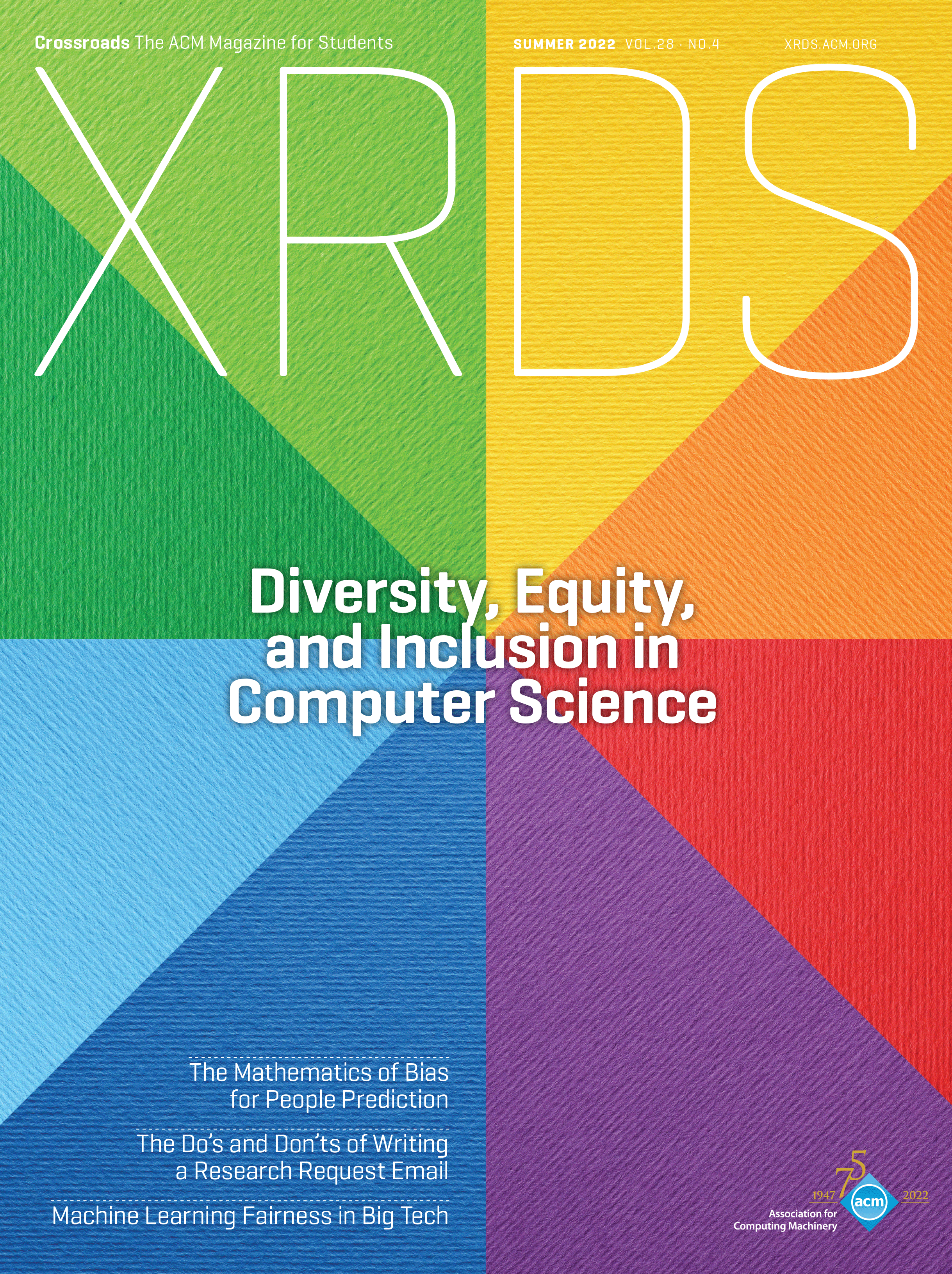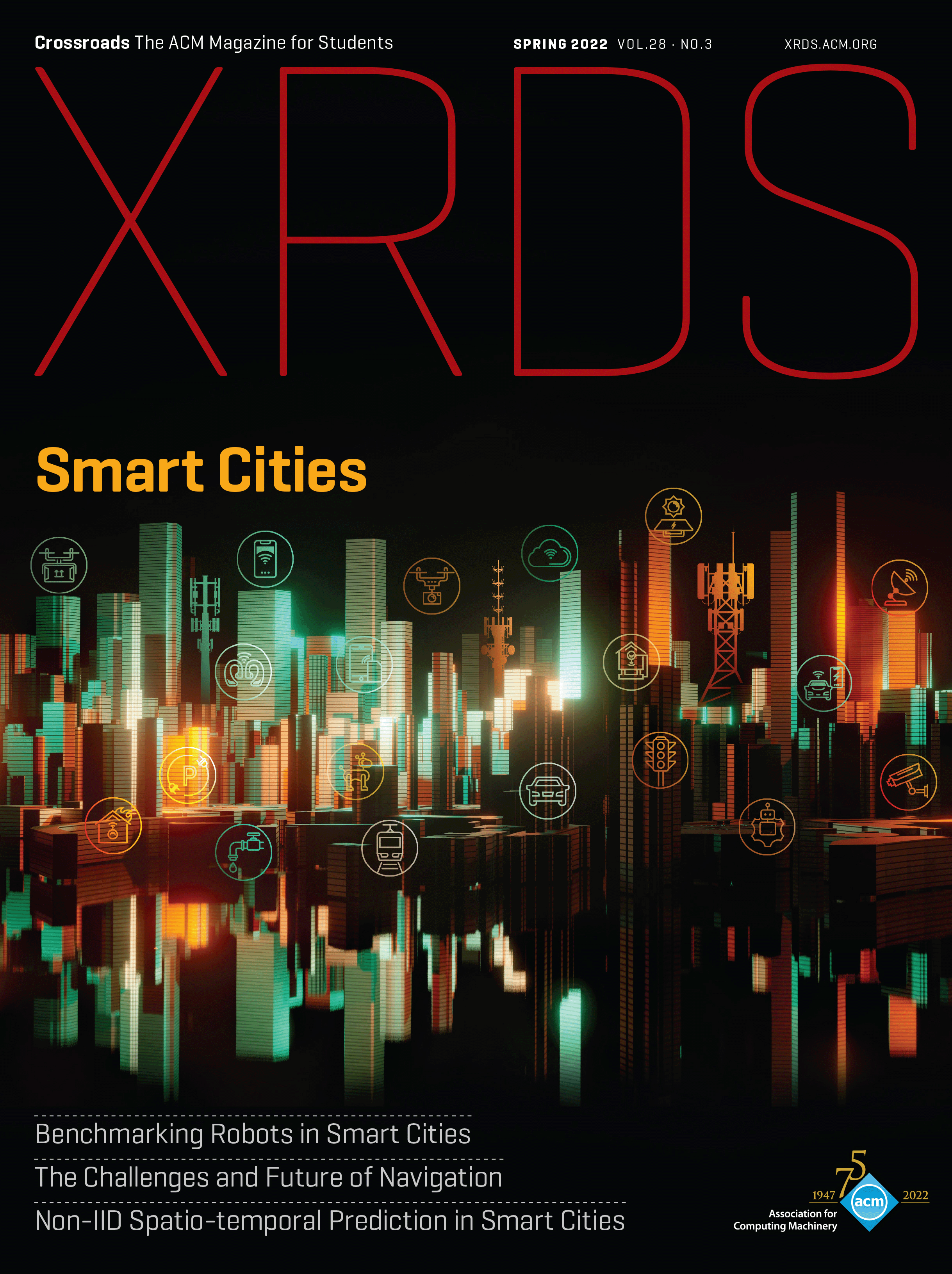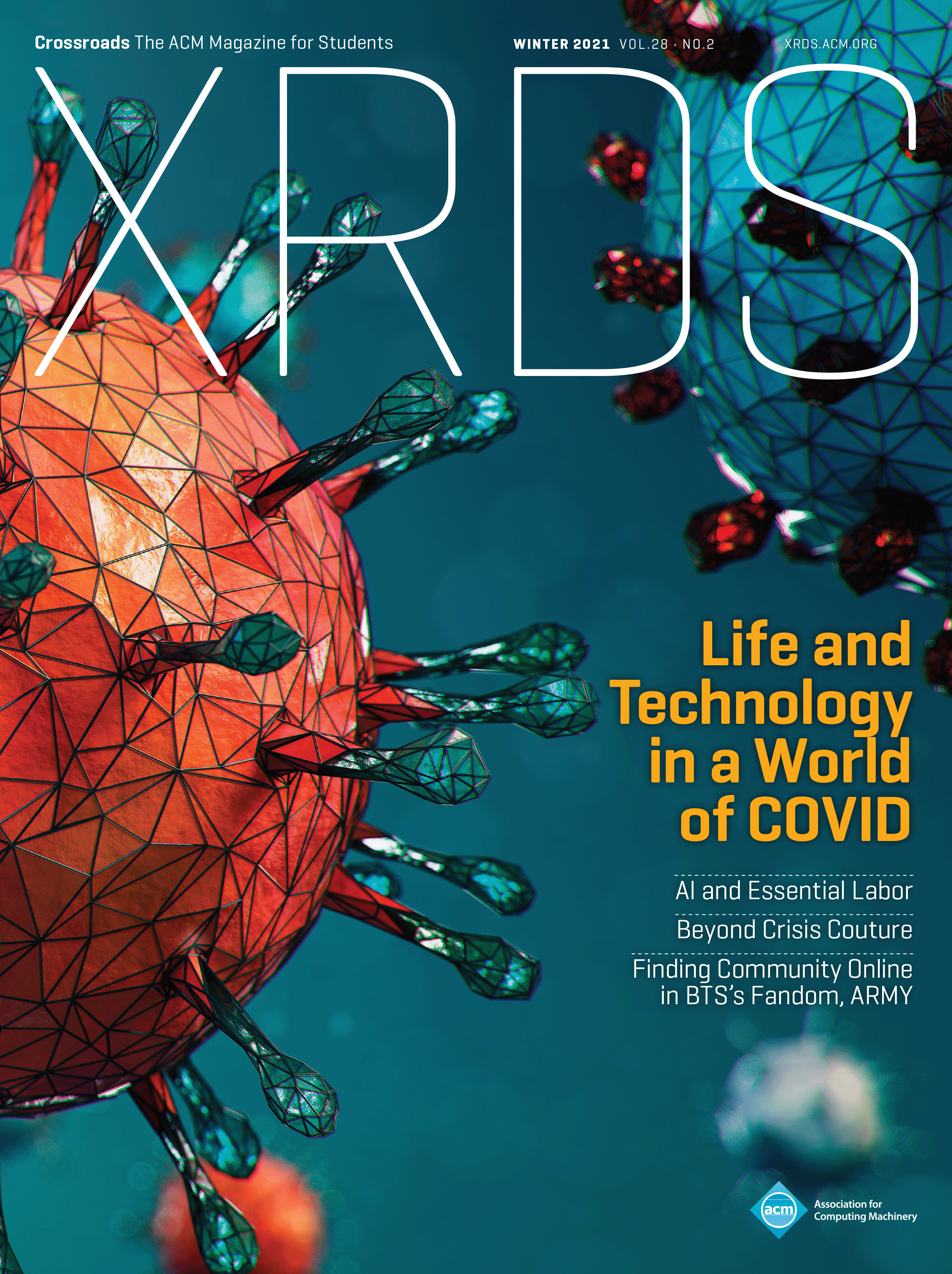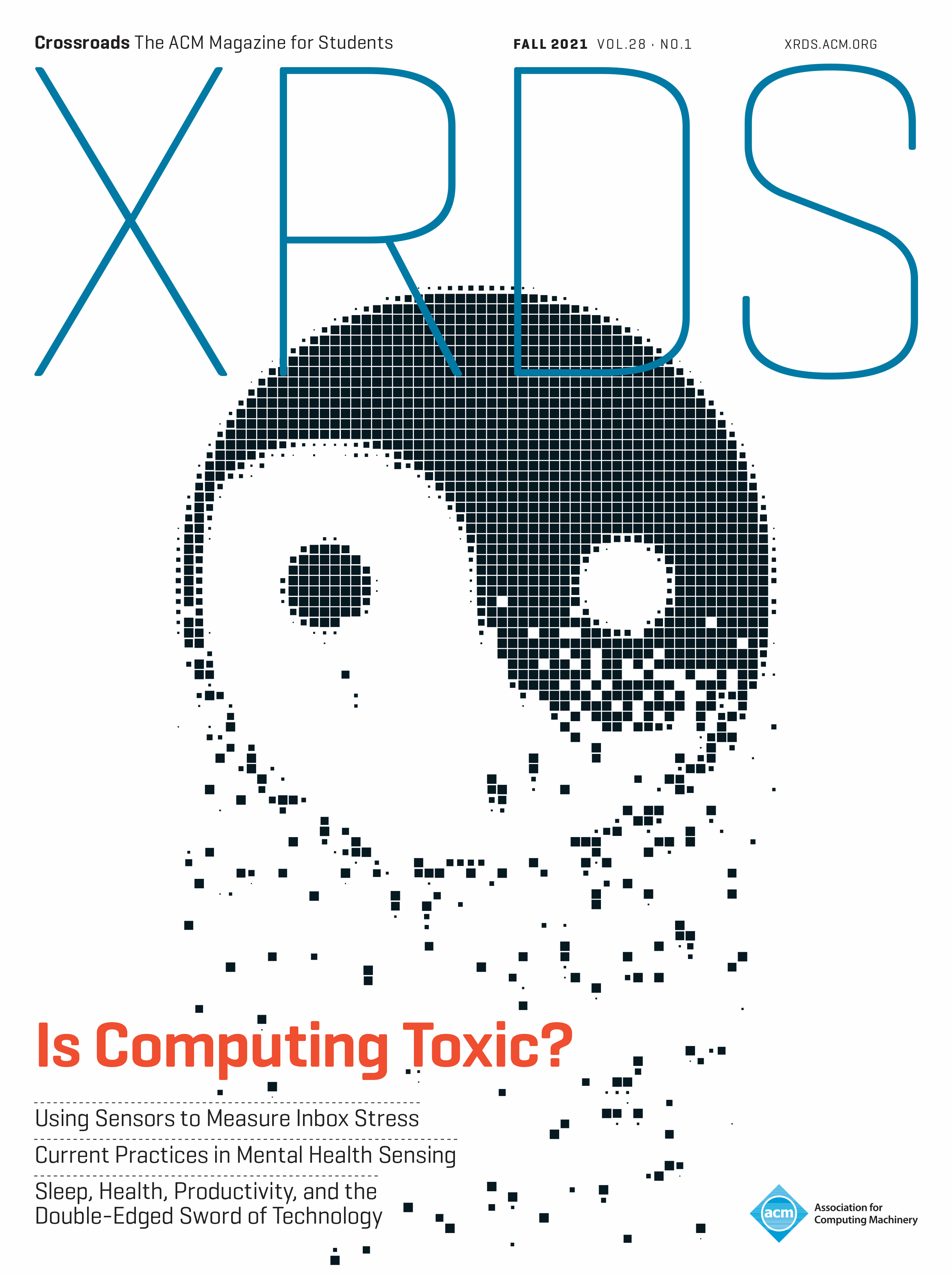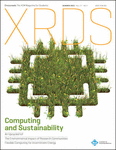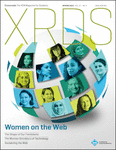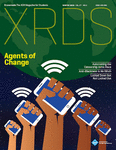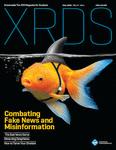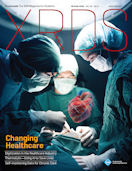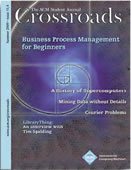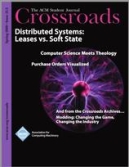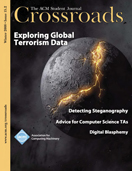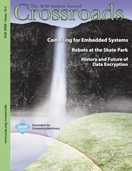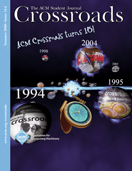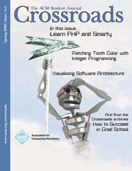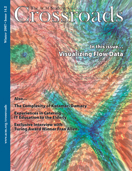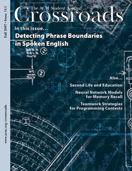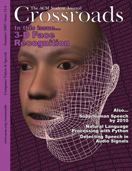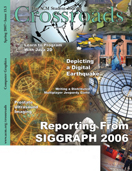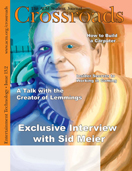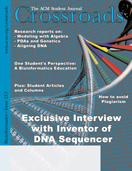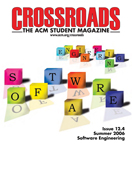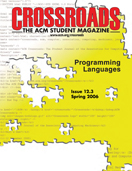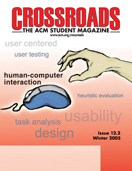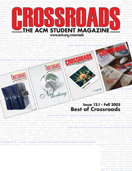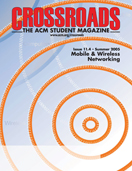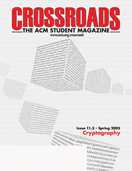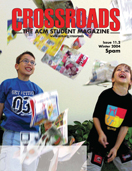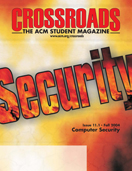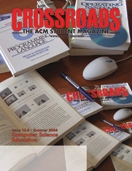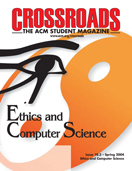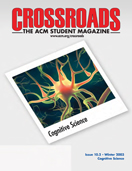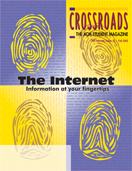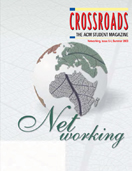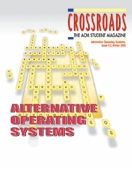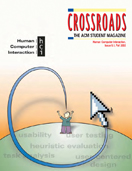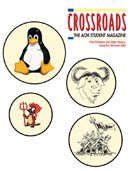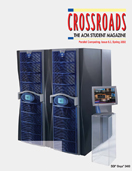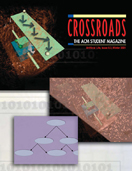Magazine: Archives
Archive
Spring 2022 | Volume 28, No. 3
A smart city harnesses the power of mobile devices and sensors to optimize the efficiency of city operations and services. It is a continuously evolving system that covers areas as disparate as public safety, traffic management, and utilities. In the past two years, we have witnessed the power of this paradigm in contending with the COVID-19 pandemic. With big data and artificial intelligence, we have been able to observe the situation in real-time, study the epidemiology of the disease, and control the course of the pandemic. What does the future of smart cities look like? Many ideas like autonomous driving and AR-based navigation come to mind, often inspired by science fiction. Some of these are well on the road to implementation, while others remain firmly rooted in the future. But there are questions we can think about today. How can we facilitate the development of smart city technologies? How do we make people’s lives better in smart cities? In this issue, we explore how smart cities can make our urban lives safer and more convenient.
Winter 2021 | Volume 28, No. 2
Technology has been weaving itself into every aspect of our lives. COVID-19 brought this to an extreme. All communities adapted and reacted to COVID-19 in unique ways. This issue features stories from a diverse set of communities finding their new normal and fighting back, including open-source hardware, black markets, accessibility advocacy, epidemic modeling, gaming, and online fandoms. These articles paint a picture of the response to COVID-19 and how it touched so many aspects of life and technology.
Fall 2021 | Volume 28, No. 1
Post-World War II, computers have greatly accelerated the development of human society. Today the prevalence of personal laptops, smartphones, and wearable devices profoundly affects our daily lives. It is hard to imagine a world before the digital age. However, with the advances of computing technology, computing’s adverse effects are now a major global concern. When computing brings efficiency and convenience, it also brings digital addiction, privacy invasion, social isolation, and more. As a result, our health conditions, interpersonal relationships, and human rights are all impacted. For example, screen overuse and sedentary postures can lead to depleted physical and mental health in the form of eyestrain, back and neck issues, insomnia, anxiety, and depression.
We, therefore, ask: “Is computing toxic?”
Summer 2021 | Volume 27, No. 4
In the information age, pursuing speed and efficiency seems to become the default setting of humankind and our technology development. People constantly ask how to be better, faster, and stronger, but the question of sustainability is often left neglected. If the original goal of technology development was to create a better future, then have we already diverged from the planned route? Can we leverage the abundant knowledge and creativity that we have today to develop new greener technology? And how can we upgrade the existing ones to be more sustainable?
In this issue, we curated a collection of articles ranging from the work of renowned academic researchers to interviews with innovators, showcasing the unlimited possibilities where computing and technology can contribute to a better future.
Our goal is to raise awareness of sustainability in technology development, by presenting research works that aim at making positive impacts on our earth, and by sharing insights into where more efforts are needed from the most creative brains. Sustainability has become a global issue to which each one of us can contribute. We firmly believe that, in the near future, we will not only ask the question of speed and accuracy, but the questions of sustainability; we will not ask the question of if, but how, technology can lead us to a better future.
Spring 2021 | Volume 27, No. 3
We know women face difficulties because of gender discrimination within the technology industry, when on the web, and even just gaining access to the web. On too many occasions women are not accorded the recognition they deserve for the work they do, are too often overlooked for promotion and career development, and still lag in web-based entrepreneurship because of all kinds of discriminatory factors. For example, women often earn less than their male counterparts for the same work, and for trans, Black, and Latinx women in the U.S. that number is even lower. Gender bias, racism, and transphobia account for who is more likely to be exposed to negative experiences like active harassment in online forums. We also know gender, sexuality, and race play a part in biases in areas such as online lending, advertising, and job applications. Indeed, simply getting access to the web is hard as a result of gender-based discriminatory gating factors. We also know biases exist within academia and that girls and women experience feelings of isolation in many educational forums in the world of engineering and computing sciences. Baldly, the endemic gender biases that are threaded throughout our societies, which pervade our business practices and the world of technology, are inscribed into the performance of and drive many web-based experiences. This issue of XRDS is about recognizing these issues, but it is also a celebration. These factors do not stop women from being highly successful on the web and in the fields of computing and engineering sciences. While challenges exist, for many being online is liberating, allowing us to look beyond pre-defined boundaries. In this issue we invited several women we know who have been and are still successful within the world of the web.
Winter 2020 | Volume 27, No. 2
Technology plays an increasingly outsized role in society. This year only solidified tech's reach. Glued to screens at home, the internet became our primary window to the world, providing a platform for activists to reflect on society's systemic ills, as well as to conspiracy theories undermining confidence in science and democracy. Governments recognized the importance of universal access to the internet—and sought to surveil it and control its discourse. Meanwhile, biased facial recognition and personal data crunching—sometimes with help from private industry—are continually used to deploy algorithms for policing and performance evaluation that are difficult to keep in check. While tech powers change, humanity ultimately got itself into this mess. Now, it's our job to clean things up.
In "Agents of Change," we feature 11 agents and collective movements working across the globe to build a habitable, equitable future empowering individual agency; the government agents who frequently stand in the way; and the technology that drives it all. Their stories demonstrate the power of research and activism in shaping our changing world, and we hope they'll convince you to connect your own work to addressing society's greatest challenges.
Fall 2020 | Volume 27, No. 1
The COVID-19 pandemic, and the subsequent proliferation of rumors and false remedies, came as a bolt from the blue and literally turned fake news into a matter of life and death. Perhaps most worrisome is the digital community has still not decided how best to combat this deluge of misinformation. Some advocate for stricter curbs and regulations. Critics of this approach worry how such regulation could impinge on freedom of expression and individual rights. Instead, they favor a laissez-faire approach where forensic technology and public awareness are allowed to develop overtime to deal with the problem more organically.
With this issue of XRDS, we wanted to address the pressing concern of fake news. Included are reflections on the work computer scientists are doing to alleviate misinformation. As well as articles highlighting what happens when government regulation and technical solutions stop working. Here's a hint: Our role as responsible citizens begins.
Summer 2020 | Volume 26, No. 4
In the free and open source software (FOSS) communities, the possibility to "view sources" is often a collaborative creation. However, the view sources metaphor extends far beyond software, even far beyond technological environments. View sources means knowing and being aware of the processes—not only ours—thinking about others, knowing what is done and how it is done, and knowing how a mechanism works, But it also means having a holistic view of the system, of society, of groups and communities, and of our own psyche. Knowing how "something" works is as important as the use we give to said "something." Understanding its working allows us to replicate processes, adapt it to our needs, and with that knowledge have the ability to transmit it, inherit it, hack it, improve it, and make universal benefit out of the process. Essentially, be a new source by understanding the source.
That is the reason why, for this issue of XRDS, we wanted to incorporate an inclusive vision on various processes, not only coming from the global North, but also rooted in Latin America. Knowing other people's processes is fundamental in countries such as Mexico, Costa Rica, Uruguay, and Argentina. The contributions that are part of this issue allow us to view sources in environments as diverse as an Argentinian prison and a feminist community in Costa Rica. From the defense of virtual territories of community radios to the inclusion of women biographies in the Spanish-language Wikipedia, we invite you to take a comprehensive view. Also within are processes derived from education, accessibility for non-sighted users, security applications usability, and the opening of genetic material.
Spring 2020 | Volume 26, No. 3
Digitalization in healthcare is for the better from many perspectives—for patients, as well as for health organizations, healthcare professionals, and society in general. Digitalized healthcare provides safer treatments and care, which in the end contributes to more lives saved and a higher proportion of people who are cured of their disease(s). This implies a higher proportion of working-age people (and those who will be working age) will be healthy enough to work, and thus financially contribute to society. Healthcare professionals are also assisted by digitalization, which can facilitate their work duties and give them support in everyday work.
As you may have recognized by now, this edition of XRDS is about changing healthcare with respect to digitalization. Even though digitalization has greatly improved healthcare from many points of views, there are still many aspects that have the potential to improve. This issue will focus on the perspective of healthcare professionals, including their experiences and thoughts about the digitalized work environment.
Winter 2019 | Volume 26, No. 2
Unlike the human fingerprint, which is immutable and unique to each individual, technology has a print that does not hold constant. It continually evolves based on the culture and context of its application. The application of technology can reflect the ethos of its users in the context that it is situated. In this winter issue, we showcase the unique appropriation of technology by computer scientists, academics, and engineers within different cultural contexts. Our goal is to give credence to the unique influence of cultural perspectives on technology use. This collection of articles is an invitation for XRDS readers to take a critical glance at the everyday experiences that exist around us all.
Fall 2019 | Volume 26, No. 1
People have long been fascinated in future devices. Buzzwords like.AI, robotics, 5G, medical IoT, and quantum computers usually come to mind when discussing future devices. But it can be difficult to image what future devices may do or how they may look.
In this issue, we take a deep dive into technologies that drive the development of futuristic devices. Two points hold true: 1. Future devices are often unexpected, 2. Future devices are driven by solid technology breakthroughs.
We have assembled a range of articles from renowned academic researchers and industry experts explaining some of the most exciting advances that are making futuristic devices possible. These articles cover utilities, user interface, programming language, new methods of communication, security and privacy issues, scalability and deployment challenges, and so on.<
Our goal is to share insights into where innovations are needed, and what is required for future devices to survive and thrive in the market. This is a call for action. We firmly believe in everyone's eventual role as a user of future devices, but some of you will also be the designers of new emerging devices. The future is now.
Summer 2019 | Volume 25, No. 4
More than ever, computer science researchers and practitioners are playing an important role in helping to shape the future of sports as a platform for entertainment, competition, education, and well-being. The application of technology and computer science within the sports world has been powered by the evolution of wearable and portable devices, as well as the ability to comprehend visual and statistical information. It is also important to mention the significant financial investment from media companies to acquire and share data on players, teams, and matches, which has been motivated by the possibility of enriching viewer experience during live sports broadcasts. The relationship between computer science and sports has changed professional basketball, tennis, football, hockey, cricket, and soccer.
Teams and trainers are also using data from matches to improve on-field performance. Technology and artificial intelligence can be beneficial for exploring raw data and building reliable physical and tactical training programs based on the available information. These applications are also in line with the adoption of cameras and video technology for refereeing.
This issue presents the digital evolution of physical competition, covering the historical perspectives of CS applications within sports; how emerging technologies can be used to incentivize not only the practice of sport but also physical activity; how technology can be used to improve experiences for athletes with disabilities; how virtual and augmented reality are circumventing physical and athletic requirements to extend the human body into the realm of “superhuman” sports; and how the impact of eSports has influenced the gaming industry in the past years.
Our aim is to showcase emerging work that represents the dynamic and evolving landscape of computer science and sports, at the personal and professional levels.
Spring 2019 | Volume 25, No. 3
The uses of artificial intelligence (AI) or intelligent, data-driven computational systems are rapidly growing. AI’s wide reach is evident even in popular discourse, where hardly a news cycle goes by without our attention drawn to some new domain application for AI. As AI systems become more commonplace, a number of questions arise as people must make sense of and interpret the actions of such systems as they interact with and otherwise encounter such systems.
This issue of XRDS features a selection of articles that cover a wide spread of domain areas, highlighting the breadth of domains and application areas implicated by contemporary AI and data-driven computational systems. The contributed articles highlight the range of ways that people interact with such systems and the unique sets of interpretive concerns that arise from such settings.
Winter 2018 | Volume 25, No. 2
The vision of this issue is to help our readers develop a more critical view of emerging technologies, to be wary of “hype” and promises of disruption, and to understand that lasting innovation is a function of time, impact, and larger societal factors.
The Winter 2018 issue of XRDS explores "fads" and "bubbles" from the past— academic and business conditions where reputation and unbounded enthusiasm were valued more than actual knowledge, impact, and tangible outcomes—as well as more recent hype, such as “unicorns” and “super unicorns”— technology start-ups that are seemingly highly valued (billions). Are they really valuable? Why or why not? And who decides? Our contributing authors express a healthy excitement and optimism for technology vs. destructive hype— one that leads to wasted time and financial pain.
But perhaps an even more important role of this Issue is to equip readers with critical perspectives toward innovation. Fads and hype come and go (as has been happening throughout history), but true innovation is long lasting. After reading this issue, we hope you will be able to sift through the noise and e skeptical about promises of the future. When we, computer scientists, better understand why hype happens and under what conditions it is beneficial, we can learn to become more grounded and truthful arbiters of the future we create.
Fall 2018 | Volume 25, No. 1
In the academic world, fall signals new students on campus, new professors to connect with, and new opportunities for learning. XRDS reaches a global audience of current and former students,
whose personal experiences have shaped their lives at
computer scientists. With a new school year underway, the XRDS team felt it was important to address a question that many have faced one time or another during their academic careers: What does it mean to be a computer scientist? To answer this question, the guest editors reached out to 18 computer scientists who "demonstrate the breadth of negotiability
within the field." Within the Fall 2018 issue you will find a wide array of topics covered, from sustainability to curriculum design. It is our hope that this issue resonates with the computer scientist who lives within us all.
Summer 2018 | Volume 24, No. 4
The ubiquitous nature of the internet means 247 connectedness: we shop, socialize, communicate, educate, and navigate online. But there is a darkside to all of this access. Myriad patches to try to fix security vulnerabilities, privacy issues, incompatibility, censorship, neutrality and data discrimination, network performance, usability and further functionality improvements have been made in an attempt to address problems and overcome common limitations. Internet organizations, committees, consortiums, task forces, authorities, boards, registries, governing bodies and corporations try hard to regulate and maintain the current version of the internet. However, no matter how sophisticated and well engineered these patches are, issues such as network interference, censorship, privacy, accessibility, unconditional network neutrality, security, and anonymity still remain.
For this issue, our contributors are trying in their
own way to alter, hinder, and fix current internet defaults—mass
surveillance, oligopoly, and censorship—either by technical developments
or policy changes, social movements, and politics.
Spring 2018 | Volume 24, No. 3
The image featured on the cover of this issue and entitled “Malala” was produced by the AICAN algorithm and was the leading artwork in the exhibition “Unhuman: Art in the Age of AI,”which took place in Los Angeles, California, and Frankfurt, Germany, in the fall of 2017. Created by Ahmed Elgammal, professor of computer science and director of the Art and Artificial Intelligence Laboratory at Rutgers University, AICAN is an algorithm that autonomously generates novel images with deep learning techniques. The algorithm was designed to answer the question, “If we teach a machine how to recognize art and styles of art, and then program it to create new images that do not follow established styles, what would it create?”
Featuring the materialization of 24 AICAN-produced images printed on unframed, metal sheets in two separate installments, “Unhuman” was the result of a selection of images from the digital constellation of visual content fabricated by the algorithm after its exposure to 80,000 digitized reproductions of paintings in Western art. The handpicked images in the exhibition and their presentation as art produced by a machine were intended to interrogate the role of artistic authorship, the concept of creativity, and the meaning of computer-generated art in the age of AI.
While the AICAN images are devoid of artistic intentionality in a direct sense, their ascribed titles, such as “Malala,” are intended to evoke a range of socio-political and conceptual associations in order to question their interpretive capacity. By far the most popular image in the exhibition, “Malala” gained its title in honor of Malala Yousofzai, the human rights activist from Pakistan, who survived being shot by the Taliban while standing up for women’s right to education. The image appears like a sanctified portrait or religious icon, noble, vivid, and strongly anchored in the foreground of the picture plane, making a direct appeal to its viewer despite its otherwise obfuscated rendering.
“Malala” and the other images produced by AICAN may be seen as the ultimate experiment in modernism, pushing the limits of the meaning of form itself, depending on where one locates the dividing line between human and machine agency in the creative act, if at all. At the core of “Unhuman” is an exploration of the role of boundaries in safekeeping those seemingly inimitable qualities that we consider the hallmarks of the human experience. To understand what is human and worth guarding as uniquely human, we ask the reader what is unhuman?
—Emily L. Spratt, Curator of “Unhuman: Art in the Age of AI”
and Chief Curator of the AICAN Art Collection
Winter 2017 | Volume 24, No. 2
There's a myth in tech culture: A myth that technology can solve any problem, bridge any gap, and create something out of nothing. And, supposedly, it has no political allegiance or agenda. However, the ways we relate to each other and to ourselves are constrained by our environments—our peers, our culture, and artifacts in the world. Because of this, it's indisputable that technology impacts intimacy, identity, and relationships. This issue explores that deeply, with the understanding that these impacts are determined by patterns of power and dominance. In other words, systemic racism, sexism, homophobia, transphobia, ableism, and other oppressions operate at all levels of our society, empowering some individuals over others. Technology can be a vehicle to perpetuate these harms, as well as a tool for resistance. It can create opportunities as well as deny them. It is undeniably political.
Fall 2017 | Volume 24, No. 1
When hearing the terms “game theory” and “gamification” for the first time, they may sound almost synonymous. Interestingly, though, the word “game” has a very different meaning for each of these terms. The “game” in game theory is any interaction where one can “cleverly” choose their action (usually to optimize their outcome). The “game” in gamification is a fun pastime activity, from which one can borrow elements and themes that help engage users. Despite the separate evolution of each of these fields, and the different meaning of the term “game” in each of them, a central theme in both of these fields is incentivizing, or motivating, users to act in certain ways. The articles that comprise this issue of XRDS aim to introduce you, our reader, to a diverse but representative sample of scenarios from the worlds of algorithmic game theory and gamification, where a program or algorithm aims to incentivize or motivate some users to act in a certain manner. In a world where many computing systems interact with anonymous users from across the globe, such concerns have become more central than ever before.
Summer 2017 | Volume 23, No. 4
The summer issue of XRDS takes a candid look at startups and entrepreneurship. Whether you're just dipping your toe in the waters or you're ready to dive in, we've assembled a selection of articles to explore the unlimited opportunities, the challenges, the heartbreaks, and the joys of tech entrepreneurship. This issue is strategically organized into three parts: an introduction to startups, open entrepreneurship, and personal perspectives. Understanding what it takes to being an entrepreneur is the first step. We've asked entrepreneurs who are at various points along their journey to share how to find collaborators, how to design a business for work-life balance, and how to develop an entrepreneurial mindset. We also explore the landscape from traditional venture capital to
alternative open source approaches for running a tech business. It is our hope that these stories will be the push you need to transform your great idea into something tangible.
Spring 2017 | Volume 23, No. 3
Globalization is a double-edged sword: powerfully positive for the human race but also positioned to be used and abused in human conflicts and crises on a local and global scale. This issue of XRDS explores some of today's most notable crises and the role technologies have played in addressing them. This issue also presents ideas and arguments from leading experts in several vertical categories of science and technology to give a holistic view on tech for crises.
Winter 2016 | Volume 23, No. 2
What will our work look like in a future characterized by artificial intelligence and autonomous systems? Perhaps more important than predicting the future is designing a future that we would actually want to live in. We all work to provide for ourselves and our families, and to seek challenges and purpose in life. In this issue of XRDS, which highlights the Future of Work, we discuss the ways technology interacts with our wants and needs by augmenting our abilities and enabling new forms of cooperation between people and machines. We also analyze the cultural, social, and ethical challenges of new forms of organizing work, such as on-demand labor and gig work. Finally, we explore what it means to design the workplace of the future as a place of fairness, trust, innovation, and growth.
Fall 2016 | Volume 23, No. 1
In this issue of XRDS, we take a closer look at the rapidly developing field of quantum computing, a form of computation fundamentally different from that of the digital computers that surround us. Our coverage includes recent advances in the field involving computer simulation, complexity theory, simulated annealing, and machine learning. Also within our pages, is an in-depth profile of the esteemed David Deutsch, the father of the quantum Turing machine, whose influence is evident throughout. However, even he would not likely have foreseen the extent to which the field has developed. From cryptography, error correction, and recommendation systems to black holes and superluminal communication, quantum computing has become a platform for ideas from a host of diverse disciplines to converge. And the technology inspired by these ideas has caught the attention of tech firms such as IBM, Microsoft, and Google, in addition to government agencies and even startups.
Summer 2016 | Volume 22, No. 4
Technology is not stagnant, it moves from place to place and person to person. In this issue of XRDS, we observe what happens when computing, culture, and postcoloniality collide. A major theme of the “Cultures of Computing” issue is how dominant narratives frame technology in terms of development for the global South—as opposed to from, or of, or with the global South.
The authors in this issue address how to decolonialize computing, the participation of Africans in the global HCI community, and the ways in which the globalization has changed cultures and given rise to new identities, new practices, and new systems. You will find representation of a variety of views. Not only from cultures around the world, but from different disciplinary cultures as well. We hope this issue will spark thoughtful and reflective discussions and debates about the role of computing in these fluid times.
Spring 2016 | Volume 22, No. 3
The gears of the medical droid whir as its mechanical arms work nimbly to replace the human’s hand severed with a new, robotic one. As the human waits, her gaze wanders out the viewport of the huge, 1200 meter-long spaceship, taking in the infinite field of stars beyond. If this scene reminds you of a galaxy far, far away, think again. Advances in digital fabrication may soon bring not only customized prosthetics, but habitable cosmic structures within the realm of possibility. This issue of XRDS focuses on how computer-controlled fabrication promises to revolutionize the way we think about how things are "made." Also discussed are issues that arise in making machines that make. How do we ensure the sustainability of a future where millions of computers are churning out physical products? Where does personal creativity fit into this? These questions—social, technological, and artistic—and more—are addressed within these pages.
Winter 2015 | Volume 22, No. 2
This forward-thinking issue focuses on the Internet of Things or IoT, a progressive state of the Internet in which every single device in the physical world is connected and possesses the ability to communicate with one another. By 2020, 6.4 billion devices will be connected to this network; the IoT has the ability to both reflect upon and transform the reality that it mirrors. In this issue we hear from Vint Cerf, the father of the Internet, on some challenges that this configuration poses. Cornell University's Dr. Alyssa Apsel and Enkhbayasgalan Gantsog discuss pivotal issues in building the IoT, such as the synchronization that creates the “connectivity” of the network. Other articles in this issue address: communication in the IoT, construction of the network, powering the devices, data transmission, as well as responses from academia and industry to this new technology.
Fall 2015 | Volume 22, No. 1
Virtual Reality (VR) opens up an immense space where computer science dives in; this special issue will be an eye-opener for emerging computer science students who are considering the world of VR; either as recent graduates ready to join the bubbling industry (think Valve, HTC, Samsung, Sony, Microsoft, Facebook, and Google), or as researchers looking to connect with fellow academics who research novel ways of experiencing VR. Within these pages, XRDS shines light on both sides of the coin.
Summer 2015 | Volume 21, No. 4
Over the past couple of decades, technology has gained an increasingly critical role in many areas of biology. We've come a long way from 2003, when the Human Genome Project successfully identified and mapped all of the genes of the human genome. Today new technologies are gaining traction for understanding gene regulation by looking at how chromosomes are packaged inside cells or how specific genomic elements induce gene editing. Where will these technologies take us next? What new algorithms will be developed to understand and integrate this data? This issue of XRDS explores computational biology in detail from personalized medicine to managing large-scale biomedical data.
Spring 2015 | Volume 21, No. 3
The Spring issue of XRDS features contributions from the who’s who of cryptography. Within are a range of articles from the early beginnings of cryptography through present-day research. Discover modern cryptographic techniques like searchable encryption, read interviews with leading researchers in the field, and enjoy a wonderful look back at Bletchley Park, home of Colossus (the world’s first electronic digital computer).
Winter 2014 | Volume 21, No. 2
More and more, technology is playing a crucial role in the reincarnation of healthcare. Today your personal health data is accessible at the touch of your fingertips. There is a growing market for mobile health apps and tracking (e.g. Apple Watch, FitBit, Jawbone etc.). With pervasive healthcare comes patient empowerment. Many of us are actively managing our own healthcare thanks to smart devices, online communities, and big data. From peer health groups to self tracking, in this issue we look at the cutting-edge research driving health informatics. Peer-oriented, collaborative allow patients to share their health information with one other; patient-contributed data is being used to discover novel medical insights; several technological efforts are helping to facilitate decision making, both on behalf of patients and on behalf of doctors; and work on interfaces and systems are helping people manage the day-to-day challenges of their medical conditions.
Fall 2014 | Volume 21, No. 1
The current issue focuses on natural language processing (NLP), with an emphasis on humanistic applications that lie at the intersection of computer science and linguistics. The articles within this issue touch upon artificial intelligence and machine learning—specifically machine translation (e.g. “Google Translate”), speech recognition and synthesis, knowledge modeling using language, automatic summarization, automatic error detection and correction—as well as softer topics, such as work on the digitization of ancient Sumerian using modern computational tools and dialect switching in Arabic. (If you are so inclined, try to find the three “Easter eggs” hidden on the cover!)
Summer 2014 | Volume 20, No. 4
When it comes to pursuing computer science, and science in general, at the doctorate level in the U.S., some groups are still lagging. Less than 6% of degree holders are Black and/or Hispanic, while 30% are women—although women make up 51% of the general population. In this issue, we tackled the following questions: Is there something inherently boring about CS to women? What are the barriers facing underrepresented minorities and women in the field? What aspects of CS in a social sense (constructs, culture) are unappealing to underrepresented groups? Why does diversity matter? Is CS—and more importantly, society—poorer for a lack of inclusivity? We hope the articles in this issue can further stimulate the conversation in and out of the classroom.
Spring 2014 | Volume 20, No. 3
Computing in the new century is no longer confined to the desk, behind a monitor. It is wireless, ubiquitous, and on the go. It has taken to the skies, the oceans, and the land all around us. These cyber-physical systems are co-habitants of a complex and advanced ecology we have built for ourselves. Cyber-physical systems are electro-mechanical systems, which harness the power of computation, communication, control, and coordination to accomplish their assigned task(s) efficiently.
In this issue, we present the concept, applications, challenges, and progress of ubiquitous computing; the technologies that make computing infiltrate into every aspect of our daily lives; and the machines and systems that reshape the air, water, and land on earth.
Winter 2013 | Volume 20, No. 2
"Wearable Computing" refers to embedding sensors and computation devices on the body in a seamless, unobtrusive, and invisible way. Such technology may very well revolutionize the way we live, behave, and interact. Beyond the current commercial applications, extensive research is being done to push the limits of wearable computing. Highlighted in this issue are applications in personal behavior monitoring, health care, and human-computer interaction. From monitoring a runner's performance in the field to using standard smartphone sensors as part of an mHealth project, there are endless opportunities to get dressed in tech.
Fall 2013 | Volume 20, No. 1
When real and digital worlds collide things can get messy. Complicated problems surrounding privacy and anonymity arise as our interconnected world evolves technically, culturally, and politically. But what do we mean by privacy? By anonymity? Inside this issue we have contributions from lawyers, researchers, computer scientists, policy makers, and industry heavyweights all of whom try to answer the tough questions surrounding privacy, anonymity, and security. From cryptocurrencies to differential privacy, we look at how technology is used to protect our digital selves, and how that same technology can expose our vulnerabilities causing lasting, real-world effects.
Summer 2013 | Volume 19, No. 4
This issue highlights how computers aid us all in realizing creative expression across various mediums. The presence of computers in our daily lives has produced an environment where various mediums coexist in a digital space where creativity can fly. Our images and data have quickly become creative artifacts. The emergence of online, collective communities, which support new forms of combined creativity, is leading to new types of creative partnerships. In many ways the tools that we use or produce for creative ends can enable or hinder artists. This all begs the question: Who owns this content? Video mashups, online music composition, animation, visual effects, computational origami are just some of the ideas explored in this issue.
Spring 2013 | Volume 19, No. 3
Solving large-scale, complex problems, such as climate change or nuclear stockpile stewardship, would be next to impossible without scientific computing. And thanks to advances in high-performance computing, scientific computing continues to flourish. Scientific computing, also known as computational science, emphasizes interdisciplinary collaboration in the development of computer programs, software applications, and computer simulations. The intersection of computer science, engineering, and applied mathematics is at the heart of scientific computing; computer-based models are used to analyze diverse scientific problems across biology, geology, chemistry, ecology, climatology, and physics, to name a few. For those of you who are computational scientists, or leaning in that direction, this issue provides a comprehensive overview of a diverse and growing field.
Winter 2012 | Volume 19, No. 2
The power of technology could improve the lives of millions of people around the world. ICTD (Information and Communication Technologies and Development) addresses some of the most critical societal issues across the globe, including healthcare, education, crime, finance, and agriculture. However the challenge for computer scientists is to not only produce feasible solutions but to do so in the context of the developing world. Not only must technical constraints be accounted for, but also there are foundational issues inherent to the target community that have to be addressed. This issue of XRDS focuses on the unique challenges and opportunities within ICTD.
Fall 2012 | Volume 19, No. 1
Big data is everywhere—from financial transactions to Tweets, from ad click throughs to medical records—and is continuously growing. The Information Age has lead to a proliferation of data across all industries. However harnessing all of this data can be a daunting task. There are many challenges facing the big data community. In this issue we provide a comprehensive overview of recent developments affecting big data. The issue is divided into three main themes: theory, systems, and applications. We've also included discussions on how data is used in the real word at IBM and Google. As more businesses use data analytics to make better strategic decisions, there is an increasing need for educated researchers, scientists, and engineers. We hope to encourage our readers to explore this growing field.
Summer 2012 | Volume 18, No. 4
In today's world of mobile apps and social media, an entrepreneurial sprit is no longer just for the adventurous. It's safe to assume that anyone with basic programming skills has considered jumping into the deep end to find success in the startup world. And it's not so surprising, considering the everyday tools we use began as startups: Google, Facebook, Twitter, Groupon, Instagram. From dedicated conferences like TechCrunch Disrupt to venture capitalist bloggers, startups are big business. We've compiled interviews and articles from those with direct experience working for, funding, and launching a startup. We hope this issue will fill in the gaps you may have about starting your own business. Perhaps upon turning that last page you realize a startup is not for you, or you may be reinvigorated to go out there and make your mark. In light of Facebook's recent IPO struggles, it's apparent that you will need more than a big idea. If you're willing to take the risk, you may be part of something that fundamentally changes how we live.
Spring 2012 | Volume 18, No. 3
2012 has been designated the "Alan Turning Year." Celebrations on both sides of the pond are being held to commemorate Alan Turing's legacy. His contributions to not only computer science, but society as well, are vast. In this special issue of XRDS, we explore what we mean by computation; consider the relevancy of Turing's work today; discuss computational complexity, while taking a detour into cryptography; and wrap up with what the future holds for computing. If Turing is the "Father of Computer Science,” we as his descendants must continue to push the boundaries of computing science.
Winter 2011 | Volume 18, No. 2
Since the passing of the Freedom of Information of Act in 1966, open government has become a term bandied about by journalists, activists, and even the current President of the United States. However more than the declassification of state secrets, information access—spurred on by the World Wide Web—has opened the door for a global movement: open democracy. The combined efforts of politicians, programmers and everyday citizens are highlighted in the latest issue of XRDS. From censorship to crimemapping, we explore how computer science can strengthen democracy.
Fall 2011 | Volume 18, No. 1
Your brain is a wonderful and powerful thing—it is intricately involved with everything you do and everything that makes you who you are. As the interests of computer scientists gravitate toward the brain, entirely new questions emerge. Can we monitor the brain while writing a paper, playing a game, or performing a musical piece? Can we study how the brain learns and use it to influence and improve our own algorithms? Can we create computer applications that are attentive to our situational cognitive needs?
Summer 2011 | Volume 17, No. 4
Although technology has improved our lives in immeasurable ways, it does have a cost. As computer scientists, engineers, designers, we often forget about the impact of our work. In this issue of XRDS, we explore the relationship between technology and environmental sustainability. Presented here are tangible ways technology is being used to inform better decisions, reduce energy consumption, and address the tradeoffs between globalization and a fragile ecosystem.
Spring 2011 | Volume 17, No. 3
It’s been one year since we redesigned and renamed the magazine. Since then we’ve introduced you to new faces,published useful tutorials, and covered a range of topics from interactivity to parallel programming. In this issue we turn to the future of banking, currency and e-commerce—as technology evolves so will our relationship with money. Thanks to our Editors for putting together another great issue.
Winter 2010 | Volume 17, No. 2
Humans are better at certain tasks than computers. In this issue of XRDS, we embrace the human side of computing and look at human computation, the act of using humans to 'compute' information, facilitated and organized with machines.
Fall 2010 | Volume 17, No. 1
What is programming? Researchers, computing professionals, biologists, teachers, and students all have different ideas of what programming means and how to do it best. In this issue of XRDS, we investigate parallel programming, biological programming, genetic programming, and more. Department editor Jason Thibodeau shares five tips for first-time programmers starting their professional careers. Contributor David L. Largent provides an overview of the agile development movement.
Summer 2010 | Volume 16, No. 4
Issue 16.4 marks the all-new XRDS. We're proud to introduce a new format, new content, and new vision for the student magazine of the ACM. Inside this issue, you'll discover a dozen new columns, things like "Advice," a tutorial called "Hello World," "Labz," and much more. You can also read a number of feature articles on the theme The Future of Interaction. No longer do we think of computing solely as sitting in front of a desktop computer with a keyboard and mouse. Computing happens everywhere.
March 2010 | Volume 16, No. 3
In this issue of XRDS, we look at how computer users, businesses, researchers, and scientists are Plugging into the Cloud. In this issue, you'll find introductory articles on cloud computing, as well more detailed analytical views of security concerns related to the cloud, research questions, business implications, and more.
December 2009 | Volume 16, No. 2
In this issue, we take a look at computing onThe Social Web. How sure are you that all your friends and connections on Facebook, Twitter, MySpace, LinkedIn, and anywhere else that your online network exists, are legitimate people posting real information? What happens when we start to ask real questions online; can computers always find the answers, or is there a point when we have to turn to real humans again? Read about these issues and more in this edition.
September 2009 | Volume 16, No. 1
In this issue, a debate about whether computer science education is headed in the right direction, career advice for software developers who are new to the profession, an interview with a senior game programmer at Firaxis Games, and an in-depth article about server virtualization architecture and implementation.














